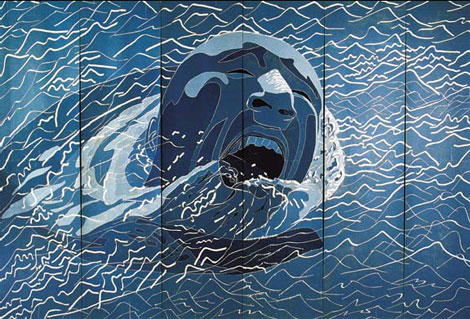A bald truth
|
|
|
Fang Lijun is a versatile artist who has tried out a wide variety of media such as oil, print, sculpture and installation. [China Daily] |
Born in 1963 in Handan, Hebei province to a humble family, Fang learned the hard way that he had a rich grandfather - a man whose lands were nationalized when New China was founded.
In 1966, the "cultural revolution" erupted across the country and intellectuals, "counter-revolutionaries" or relatives of capitalists and one-time landowners were denounced.
Fang remembers that as a child, he was told his family had a problematic background.
From an early age, he had to cope with a world where "social and political currents changed almost overnight; and where human nature often turned brutal".
"I was shocked by all this," he says. "In some ways, you had two thoughts in your head. One was that your family was bad; the other was the warmth you felt toward them."
Fang's father, a railroad engineer, was dispatched to the countryside for his "reform" and Fang once joined a denunciation session, only to discover that the man being slammed was his own grandfather.
Schools were closed, boys went fishing, or engaged in petty thievery, and when they played games, Fang always lost, because the other boys insisted he was a loser.
"'You can't win'," he says they would tell him. "'You come from a bad family'."
He learned early to play by the rules of the game: to taunt, to make fun, to appear to be in a crowd, even if he wasn't with it.
Strangely, it was all this that opened the door to his art.
Fang says his father worried about him getting into trouble, and so bought the young boy art supplies, and also hired an art teacher.
In the years that followed, Fang took classes in fine art and sought apprenticeships with various local teachers.
After the "cultural revolution", Fang went on to study ceramics at Hebei Light Industry Technical College, Tangshan, Hebei province.
After graduation, he got a job at an advertising agency, but soon grew bored and left to strike out on his own.
He tried opening his own advertising agency, but spent much of his time doing odd jobs, like construction work.
Life became increasingly difficult and he decided to go back to school
Eventually, he enrolled at the Central Academy of Fine Arts, in 1985, just as the Beijing art scene began to blossom with the 1985 New Wave Art movement.
After graduation, Fang joined the Yuanmingyuan Artists village, a bohemian artistic community on the outskirts of Beijing.
It was here that he forged his style of painting that came to be known as "Cynical Realism."
Looking back, Fang admits he has a bittersweet feeling toward the label Cynical Realism attached to his art by influential critics such as Li Xianting.
"It is like a double-edge sword, on the one hand giving me wealth and fame but on the other, burying the original motivations of my work."
While Fang refuses to link his art with politics, this link is inevitably made when he is introduced to Western viewers and collectors.
"I have never deliberately revealed politics or China's reality in my works. I just try to express my feelings," he argues.
Asked why he clings to his trademark icons such as baldheads and babies instead of trying something different, Fang says: "It is not easy for a vanguard artist to come up with a new icon. And any artist is entitled to exploit his or her creations
"For me, art and business have no problem sitting on the same bench."
 0
0 








Go to Forum >>0 Comments